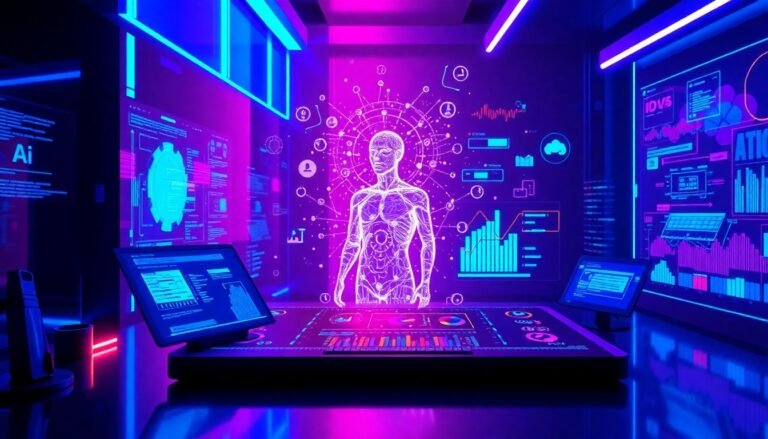How AI in Public Safety is Transforming Our World in 2025

Introduction to AI in Public Safety
The integration of artificial intelligence (AI) in public safety represents one of the most significant advancements in enhancing the security and well-being of communities globally. AI in public safety refers to the deployment of intelligent systems designed to support law enforcement, emergency response, and disaster management, among other critical areas. As society evolves, the relevance of these technologies continues to grow, offering innovative solutions that improve response times, predictive capabilities, and resource allocation for both public and private sectors.
In recent years, public safety organizations have recognized the potential of AI to transform traditional practices. By leveraging machine learning, data analytics, and advanced algorithms, agencies can analyze vast amounts of data rapidly and accurately. This dynamic allows for a proactive approach to crime prevention and emergency preparedness. For instance, AI-driven platforms can analyze crime patterns and predict future incidents, enabling law enforcement to allocate resources more effectively and engage in community policing. Similarly, emergency services can utilize AI to optimize response strategies during crises, ensuring that help arrives promptly where it is needed most.
This blog post aims to explore the multifaceted impact of AI in public safety, particularly as we approach 2025. Readers will gain insights into the technologies that are set to revolutionize emergency management, law enforcement, and community safety initiatives. We will discuss specific applications of AI, challenges faced in its implementation, and case studies that illustrate the successful integration of these technologies. By understanding the ongoing developments in AI and its future applications in public safety, stakeholders can better prepare for a safer, more secure environment.
The Evolution of Artificial Intelligence in Emergency Response
Artificial Intelligence (AI) has significantly transformed the landscape of emergency response over the last few decades. Initially, AI applications were limited to basic data analysis and decision support systems. The evolution of this technology moved from simple algorithms to sophisticated machine learning platforms capable of adapting to new information. Early applications in emergency management included predictive analytics for forecasting disasters, utilizing historical data to identify patterns and assess risks. As technology advanced, so too did AI’s capabilities in gathering real-time data, enabling better preparedness and response.
Currently, AI is integrated into various facets of emergency response. For instance, AI-driven systems are now employed to analyze large datasets from multiple sources, such as social media and satellite imagery, to provide situational awareness during crises. Automated drones equipped with AI capabilities can scan and map disaster-stricken areas, offering invaluable insights for first responders. Additionally, Natural Language Processing (NLP) technologies are utilized in emergency call centers, enhancing communication efficiency by quickly triaging calls and directing resources more effectively. Such innovations underscore how AI in public safety is not merely about technological advancements but also about improving human coordination and response times during emergencies.
Looking ahead to 2025, we anticipate even greater advancements in AI that will reshape emergency response strategies. For example, the integration of AI with the Internet of Things (IoT) may facilitate real-time monitoring of environmental conditions, thereby predicting potential emergencies more accurately. Moreover, advancements in AI algorithms could lead to improved decision-making frameworks that assist responders in chaotic situations. The use of AI for training simulations will also be essential, equipping responders with the tools and scenarios needed to act decisively during real-life emergencies. This trajectory illustrates how the ongoing evolution of AI in public safety is poised to create a more effective and resilient emergency management framework.
AI for Law Enforcement and Public Services: A Game Changer
The integration of AI in public safety is reshaping the landscape of law enforcement and public services. One of the most significant applications is in crime prediction, where AI algorithms analyze historical crime data to identify patterns and trends. This predictive policing can help law enforcement agencies allocate resources more effectively, ensuring that personnel are deployed to areas with a higher likelihood of criminal activity. By leveraging AI technology, departments can anticipate and prevent crimes before they occur, thereby enhancing public safety and ensuring a quicker response to incidents.
Another critical application of AI in public safety is in resource allocation. Traditional methods often rely on human judgment, which can be subjective and inconsistently applied. AI systems can process vast amounts of data rapidly, providing insights into optimal resource distribution based on real-time needs. For example, AI can identify which neighborhoods require additional patrols or which public services need more attention, allowing for a more strategic and efficient approach to managing public safety resources.
Moreover, improved communication is another area where AI in public safety proves invaluable. AI-driven chatbots and virtual assistants can facilitate quicker communication between law enforcement, community members, and public service entities. These tools enhance connectivity, offering real-time updates on safety concerns and responding efficiently to public inquiries. This advancement not only streamlines communication processes but also builds trust within the community, as residents feel more informed and engaged in maintaining their safety.
As AI continues to evolve, its applications in law enforcement and public services are expected to grow. The potential for improved efficiency, better resource allocation, and enhanced community engagement creates a promising outlook for public safety in the coming years. By embracing AI technologies, officials can ensure that they meet the demands of an increasingly complex safety landscape while fostering community trust.
AI Surveillance and Safety Systems: Monitoring for a Safer Future
The application of artificial intelligence (AI) in public safety is rapidly evolving, particularly through the deployment of AI surveillance systems. These advanced technologies are increasingly utilized in urban areas to enhance crime prevention strategies and improve overall public safety. By employing sophisticated algorithms, AI is capable of analyzing vast amounts of real-time data collected from various surveillance sources, such as cameras and sensors, enabling law enforcement agencies to respond more swiftly to incidents.
AI surveillance systems contribute significantly to urban security by identifying suspicious behavior patterns, recognizing faces, and even predicting potential criminal activities through predictive analytics. This proactive approach aids in deterring crime and promoting rapid intervention, thereby creating a safer environment for citizens. Furthermore, AI has the capability to integrate with existing infrastructure, facilitating a more cohesive and efficient public safety ecosystem.
<phowever, a=”” advocacy=”” ai=”” among=”” and=”” balance=”” between=”” build=”” collected,=”” concerns=”” considerations.=”” critical=”” data=”” debates=”” ensuring=”” essential=”” ethical=”” for=”” groups,=”” have=”” how=”” implementation=”” important=”” in=”” individual=”” is=”” issue.=”” maintaining=”” misuse=”” of=”” ongoing=”” p=”” policymakers,=”” potential=”” privacy=”” processed,=”” public=”” public.=”” raises=”” regarding=”” remains=”” rights=”” safety=”” sparked=”” surveillance=”” systems.
Moreover, addressing biases inherent in AI algorithms is crucial. If not properly managed, these biases can lead to discriminatory practices in law enforcement, further eroding public trust. A comprehensive framework that includes oversight, accountability, and ethical guidelines is necessary to mitigate these risks and foster a supportive environment for AI surveillance in public safety. By assessing the implications of these technologies responsibly, we can harness the power of AI to create safer cities while respecting citizens’ rights and freedoms.
Predictive Policing with AI: Enhancing Crime Prevention
Predictive policing represents a revolutionary approach in the realm of law enforcement, utilizing the advancements of AI in public safety to enhance crime prevention strategies. This technology allows police agencies to anticipate criminal activities by identifying potential crime hotspots based on historical data and quantitative analysis. By harnessing algorithms and machine learning, law enforcement can make informed decisions about resource allocation, enabling them to deploy officers strategically in areas with a higher likelihood of criminal occurrences.
The effectiveness of predictive policing hinges on the integration of various datasets. These often include historical crime reports, socioeconomic data, and community input, creating a comprehensive overview of crime patterns. AI algorithms analyze this data to identify trends and correlations that would be difficult for human analysts to discern quickly. For instance, by examining patterns of thefts or violent incidents, AI can pinpoint specific locations and times where certain crimes are more likely to happen. This proactive approach not only improves response times but also fosters community trust, as police agencies can demonstrate a commitment to reducing crime through intelligent, data-driven actions.
Moreover, the technology that supports AI in public safety continues to evolve. Tools such as geographic information systems (GIS) and real-time data analytics platforms enhance the capability of predictive policing. GIS allows for visual mapping of crime data, making it easier for law enforcement to recognize spatial patterns when strategizing for enhanced public safety. Combining these technological advancements with the insights derived from AI strengthens the overall effectiveness of predictive policing initiatives. In adopting this forward-looking strategy, law enforcement agencies are better equipped to address potential threats before they escalate, ultimately contributing to a safer society.
Smart City AI Applications: Integration in Public Infrastructure
The integration of artificial intelligence (AI) in public safety through smart city applications has begun to revolutionize urban living. As cities evolve, the deployment of AI technologies is proving essential in enhancing public safety while improving the quality of life for residents. One principal area of focus is traffic management, where AI-powered systems analyze real-time data from various sources, including sensors and cameras, to optimize traffic flow dynamically. This not only reduces congestion but also minimizes the number of accidents, enabling a safer environment for all commuters.
Furthermore, emergency response coordination benefits immensely from AI capabilities. By leveraging predictive analytics and machine learning models, public safety agencies can anticipate incidents and allocate resources more effectively, ensuring timely responses to emergencies. These intelligent systems can analyze historical data and current trends to predict high-risk areas during particular times, facilitating proactive measures that enhance community safety.
AI in public safety also fosters community engagement through innovative technology platforms. For example, residents can access information about public services, emergency alerts, and community initiatives via mobile applications powered by AI. These platforms allow for constant interaction between citizens and local authorities, creating a collaborative approach to safety. Consequently, this opens avenues for feedback and improved transparency, which are crucial for building trust in public institutions.
Moreover, the integration of AI within public infrastructure can be seen in smart surveillance systems that utilize facial recognition and behavior analysis algorithms. Such technologies help law enforcement monitor areas prone to crime, allowing for better resource allocation and crime prevention strategies. As cities adopt these advanced systems, the role of AI in public safety continues to expand, making urban areas more resilient and safer for everyone living within them.
Government Use of AI for Disaster Response
The integration of artificial intelligence (AI) in public safety initiatives plays a crucial role in enhancing governmental responses to disaster scenarios. Governments worldwide are increasingly utilizing AI technologies to improve disaster preparedness, response, and recovery processes. These advancements enable authorities to manage resources more efficiently, anticipate crises, and respond effectively to emergencies.
One of the most significant applications of AI in public safety is predictive analytics, which allows governments to assess various data points to forecast potential disasters. For instance, AI algorithms can analyze weather patterns, seismic activity, and historical data to predict when a natural disaster, such as a hurricane or earthquake, is likely to occur. By utilizing this information, governmental agencies can formulate proactive strategies to evacuate populations and deploy emergency services in advance, significantly minimizing human and material losses.
Moreover, case studies from multiple regions illustrate the successful implementation of AI technologies in disaster response. For example, following the devastating wildfires in Australia, AI systems were deployed to analyze satellite imagery and assess fire behavior. This enabled emergency services to allocate resources precisely where they were needed most, resulting in more effective firefighting measures and rescue operations. Another notable instance is the use of AI-driven drones during floods to deliver real-time data on water levels and identify affected areas, thus guiding rescue teams towards those in need of assistance.
However, the application of AI in public safety is not without challenges. Key lessons learned from these implementations emphasize the importance of data accuracy and accessibility, as well as the collaboration between various governmental agencies. Successful integration of AI solutions will require continuous improvements and adaptation to new crisis scenarios, ensuring that interventions remain effective in swiftly addressing the needs of affected populations. By addressing these challenges head-on, governments can enhance their disaster response initiatives through the efficient use of AI in public safety.
Challenges and Ethical Considerations in AI Public Safety
The integration of AI in public safety presents significant challenges and ethical dilemmas that must be addressed to ensure its responsible deployment. One of the foremost concerns is the potential for bias in AI algorithms. As machine learning systems rely on historical data to make predictions, any existing biases within this data can lead to discriminatory outcomes. This is particularly problematic in areas such as predictive policing and surveillance, where biased algorithms might disproportionately target specific demographics, undermining trust in public safety initiatives.
Another pressing issue is data privacy. As AI systems increasingly collect and analyze vast amounts of personal data to enhance security measures, concerns about individuals’ privacy rights emerge. The unauthorized use of this data can lead to surveillance overreach, eroding civil liberties and public trust. Additionally, many citizens are unaware of the extent to which their data is being utilized, heightening the need for transparency and informed consent when implementing AI technologies in public safety.
Accountability also poses a significant challenge in the realm of AI in public safety. Determining who is responsible for decision-making errors made by AI systems can be complex, particularly if those systems malfunction or produce unintended consequences. The challenge is exacerbated by the often opaque nature of AI algorithms, which can make it difficult to ascertain the rationale behind specific decisions. Establishing clear lines of accountability is necessary to mitigate risks and ensure that public safety measures are both effective and just.
Finally, the rapid evolution of AI technologies has outpaced existing regulations, underscoring the critical need for comprehensive legal frameworks. Policymakers must develop regulations that not only promote innovation but also protect citizens from potential abuses stemming from AI applications in public safety. Striking the right balance will ultimately determine how effectively AI can enhance public safety while respecting ethical boundaries and maintaining public trust.
The Future of AI in Public Safety: What Lies Ahead?
The trajectory of AI in public safety is poised for remarkable advancements as we look beyond 2025. As the integration of artificial intelligence becomes increasingly sophisticated, we can anticipate a transformative shift in how law enforcement, emergency services, and community safety initiatives operate. One of the most significant trends is the convergence of AI with existing technologies such as the Internet of Things (IoT). This synergy is expected to enhance real-time data collection and facilitate a proactive approach to public safety issues.
Emerging technologies in AI will likely refine the algorithms used for predictive policing and threat assessment. These advancements may lead to improved accuracy in identifying potential crime hotspots, allowing resource allocation to be more strategic and effective. As machine learning models evolve, they will analyze vast amounts of data from various sources, including social media, surveillance footage, and historical incident reports, thereby enabling law enforcement to develop deeper insights into patterns and trends.
Moreover, the future will see an increased focus on ethical considerations in the deployment of AI in public safety. As the technology evolves, there will be a pressing need to ensure transparency, accountability, and fairness in AI systems. This can include the formulation of guidelines and standards that govern the ethical use of AI technologies, ensuring they serve the interests of all communities, particularly marginalized groups who may be disproportionately affected by surveillance and policing strategies.
In conclusion, the future of AI in public safety promises both challenges and opportunities. The potential for technological advancements to create safer environments is immense, but it must be balanced with a commitment to ethical practices. Continued innovation and collaboration will ultimately shape a landscape where communities can thrive, protected by the intelligent systems designed to serve and secure them.
Read more
AI in Agriculture Automation: Revolutionizing Farming for a Smarter Future






Great insightsAI in Public Safety Comment on how AI is enhancing public safety. I’m particularly intrigued by the use of predictive analytics in law enforcement—it raises important questions about balancing proactive policing with ethical considerations. Curious to see how agencies will ensure transparency and accountability as these technologies evolve.